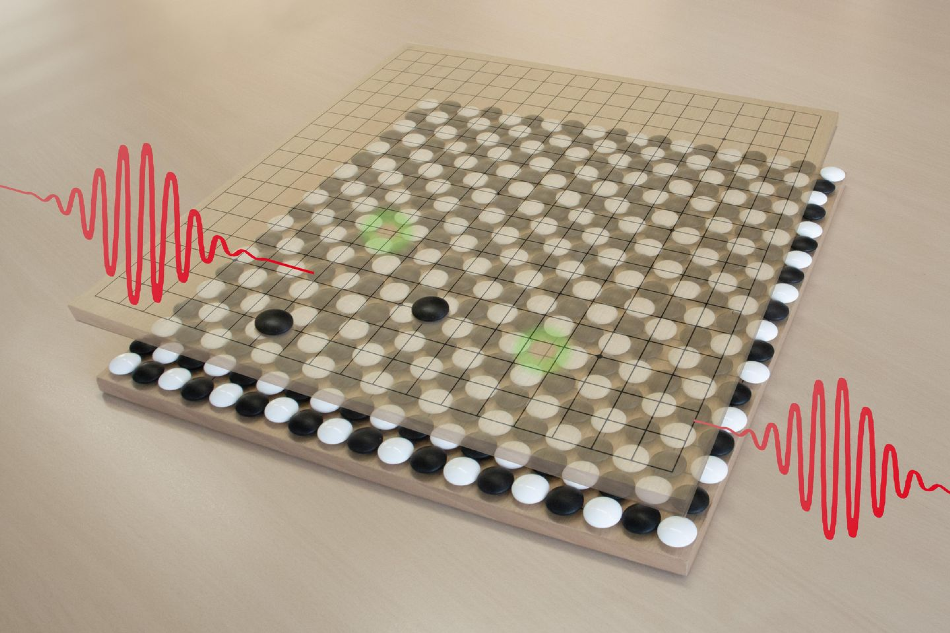Feb 5 2020
Different kinds of particles exist in physics. While elementary particles form the fundamental building blocks of matter, other particles like atoms are bound states that consist of various smaller constituents.
 Two electrons and two holes, created by light quanta, held together by a chessboard-like background. Image Credit: TU Wien.
Two electrons and two holes, created by light quanta, held together by a chessboard-like background. Image Credit: TU Wien.
In addition, there exist what are called the “quasi-particles,” excitations that occur in a system that includes many particles; quasi-particles act like a particle themselves in various ways.
Researchers at TU Wien (Vienna) have now discovered such a quasiparticle named pi-ton using computer simulations. This quasiparticle is made of two electrons and two holes. The new particle has been described in an article published in the journal Physical Review Letters. Experimental detection of the pi-ton has also been illustrated in the article.
A Hole is Almost a Particle
The simplest quasi-particle is a hole. Let us imagine, for example, that many atoms are arranged in a regular pattern in a crystal and that there is a moving electron at each atom. Only at one particular atom the electron is missing—this is called a hole.
Karsten Held, Professor, Institute for Solid State Physics, TU Wien
Subsequently, it is possible for an electron to move up from the adjacent atom. The original hole is occupied, but a new hole is formed.
Rather than defining the motion of electrons that constantly move, the motion of the hole is easier to study. The hole moves to the left when the electrons move to the right. Moreover, this movement obeys some physical rules, quite similar to how an ordinary particle moves. But, in contrast to an electron, which can also be seen external to the crystal, the hole occurs only in combination with the other particles. Here, the discussion is about a “quasi-particle.”
“However, the dividing line between particles and quasi-particles is not as clear as one might think,” stated Karsten Held.
Strictly speaking, even ordinary particles can only be understood in the context of their environment. Even in a vacuum, particle-hole excitations occur constantly, albeit for a very short time. Without them, the mass of an electron for example would be completely different. In this sense, even in experiments with ordinary electrons, what we see is really a quasi-particle electron.
Karsten Held, Professor, Institute for Solid State Physics, TU Wien
More Complicated Bonds
However, there can occur quasi-particles that are more complex: for instance, the exciton that plays a vital role in semiconductor physics. It is a bound state that is formed of an electron and a hole that is created by light. The electron has a negative charge, and the hole—which is the absence of a negative charge—has a positive charge. Both exhibit the tendency to attract each other and form a bond.
“We actually wanted to investigate such excitons,” stated Dr Anna Kauch and Dr Petra Pudleiner, the first authors of the study. “We developed computer simulations to calculate quantum physical effects in solids.”
However, not so later, Dr Kauch, Dr Pudleiner, and their colleague Katharina Astleithner understood that they had chanced upon something completely distinct in their calculations—a totally new kind of quasi-particle. It is made up of two electrons and two holes that connect with the external world through photons.
“Pi-ton” was the name given by the researchers to this previously unknown object.
The name pi-ton comes from the fact that the two electrons and two holes are held together by charge density fluctuations or spin fluctuations that always reverse their character by 180 degrees from one lattice point of the crystal to the next—i.e. by an angle of pi, measured in radians.
Dr Anna Kauch, Study First Author, TU Wien
“This constant change from plus to minus can perhaps be imagined like a change from black to white on a chessboard,” noted Petra Pudleiner. The pi-ton forms spontaneously through the absorption of a photon. A photon is emitted again when the pi-ton vanishes.
The Particle that Came out of the Computer
To date, discovery and verification of the pi-ton have been done through computer simulations. The researchers involved in this study have no doubt about its existence: “We have now investigated the phenomenon of the pi-ton using various models—it shows up again and again. Therefore, it should definitely be detectable in a variety of different materials,” Karsten Held is convinced.
Karsten Held added, “Some experimental data obtained with the material samarium titanate already seem to point to the pi-ton. Additional experiments with photons and neutrons should soon provide clarity.”
Although innumerable quasiparticles constantly exist everywhere, it is really special to discover a new quasiparticle species. Apart from the exciton, now, there is also the pi-ton. Regardless, this offers in-depth insights into the coupling between solids and light, a topic that has a crucial role to play not just in basic research but also in various technical applications—ranging from semiconductor technology to photovoltaics.